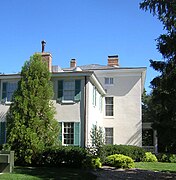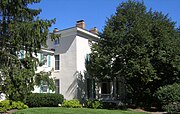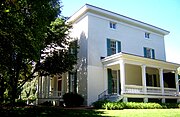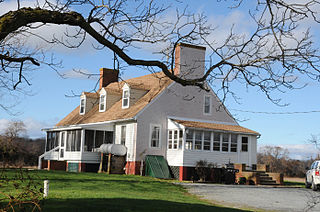
Bachelor's Hope is a historic house in Centreville, Maryland. Built between 1798 and 1815, it was added to the National Register of Historic Places in 1984.

Cedarcroft is a distinctive residential neighborhood in the North district of Baltimore, bordered by Gittings, East Lake and Bellona Avenue avenues and York Road. According to Baltimore City's Commission for Historical and Architectural Preservation (CHAP), the houses in Cedarcroft are in the Dutch Colonial Revival, Federal Revival, Tudor Revival, Georgian Revival, Cape Cod Revival, Bungalow, and Italianate styles of architecture.
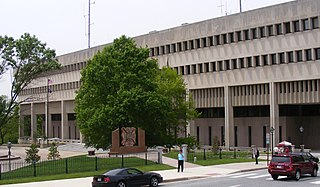
The Baltimore County Courthouses are located in Towson, Maryland, the county seat of Baltimore County, Maryland. The older, original Baltimore County Courthouse was built between 1854 and 1856. It has had three additions that eventually formed an 'H' shape. It houses many of the offices of the county government, including the executive branch, county executive, and their departments, agencies, boards, commissions, and other bodies, and the county council.

The Brice House is, along with the Hammond-Harwood House and the William Paca House, one of three similar preserved 18th century Georgian style brick houses in Annapolis, Maryland. Like the Paca and Hammond-Harwood houses, it is a five-part brick mansion with a large central block and flanking pavilions with connecting hyphens. Of the three, the Brice House's exterior is the most austere, giving its brickwork particular prominence. The Brice House was declared a National Historic Landmark in 1970.

Tulip Hill is a plantation house located about one mile from Galesville in Anne Arundel County in the Province of Maryland. Built between 1755 and 1756, it is a particularly fine example of an early Georgian mansion, and was designated a National Historic Landmark in 1970 for its architecture.
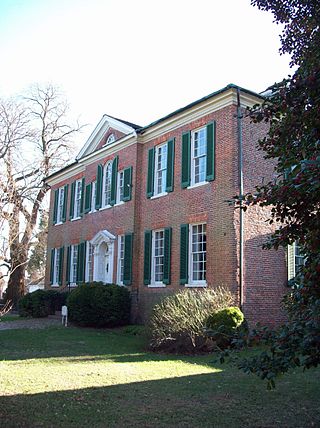
His Lordship's Kindness, also known as Poplar Hill, is a historic plantation estate on Woodyard Road east of Clinton, Maryland. It was built in the 1780s for Prince George's County planter Robert Darnall. The five-part Georgian mansion retains a number of subsidiary buildings including a slave's hospital and a dovecote. The property is now operated as a museum by a local nonprofit preservation group. It was designated a National Historic Landmark in 1970.

Riversdale, is a five-part, large-scale late Georgian mansion with superior Federal interior, built between 1801 and 1807. Also known as Baltimore House, Calvert Mansion or Riversdale Mansion, it is located at 4811 Riverdale Road in Riverdale Park, Maryland, and is open to the public as a museum.
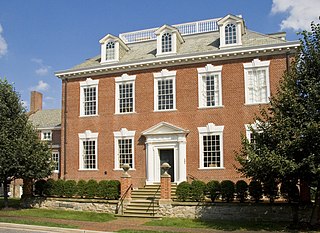
Widehall is a historic and architecturally significant house in Chestertown, Kent County, Maryland. Built by Thomas Smyth III, 1769–1770, it is a contributing property in the Chestertown Historic District.

The West Dennis Graded School is a historic school building at 67 School Street in Dennis, Massachusetts. The two story Greek Revival building was built in 1867, and is the only one of five schools built by the town in that period to survive. In the 1920s the building also served as a polling place and a site for town meetings. It was converted for use as a community center in the 1950s. The school was listed on the National Register of Historic Places in 2000.
Big Bottom Farm is a farm in Allegany County, Maryland, USA on the National Register of Historic Places. The Greek Revival house was built circa 1845, possibly by John Jacob Smouse, and exhibits a level of historically accurate detailing unusual for the area. The property includes a late 19th-century barn and several frame outbuildings.
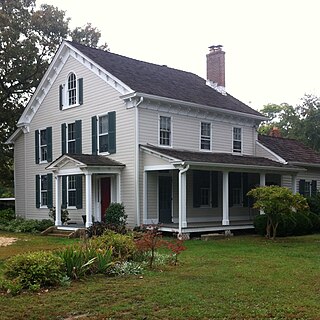
The old St. Mary's Rectory is a gable-front 21⁄2-story frame dwelling of three by three bays, built in 1849 and enlarged to twice its size in 1856, and located in Aquasco, Prince George's County, Maryland. The structure is significant for its architecture and for its association with the history of St. Paul's Parish and the community of Aquasco. The rectory is an excellent example of a vernacular building with Greek Revival and Italianate stylistic elements. The floor plan exemplifies a style typical of the dwellings of successful landowners and merchants of the mid-19th century in Prince George's County. Original Greek Revival style elements include the front gable entrance facade, crown molded returned cornice, porch detail, interior stair detail, door and window surrounds, and the parlor mantel. Italianate elements include the heavy bracketing of the exterior cornice and the tripartite window in the north gable end.
Green's Inheritance is a historic home located at Pomfret, Charles County, Maryland, United States on Piscataway Conoy land. It is a 2+1⁄2-story gable-roofed house of common bond brick, built about 1850. The house has a basic Georgian plan. It is the only brick house in Charles County dating between the years 1835 and 1880. The house was built by Francis Caleb Green, on part of the 2,400 acres (970 ha) of land granted in 1666 to the sons of Thomas Greene, the second Provincial Governor of Maryland, who named it "Green's Inheritance."

Rose Hill Manor, now known as Rose Hill Manor Park & Children's Museum, is a historic home located at Frederick, Frederick County, Maryland. It is a 2+1⁄2-story brick house. A notable feature is the large two-story pedimented portico supported by fluted Doric columns on the first floor and Ionic columns on the balustraded second floor. It was the retirement home of Thomas Johnson (1732–1819), the first elected governor of the State of Maryland and Associate Justice of the United States Supreme Court. It was built in the mid-1790s by his daughter and son-in-law.
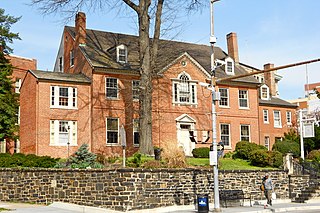
St. Paul's Church Rectory, located a block west of Old St. Paul's Episcopal Church is a historic Episcopal rectory located on steep "Cathedral Hill" at the northeast corner of Cathedral Street and West Saratoga Streets in downtown Baltimore, Maryland, United States. In the rear of the old rectory is a small alley-like extension of West Pleasant Street and to the east behind the North Charles Street former residences and now commercial structures, is another small alley extension of Little Sharp Street.
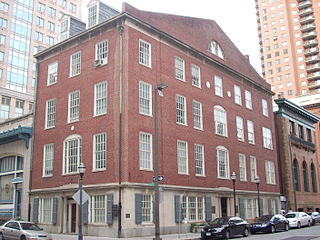
Canton House is a historic office building located on the northeast corner of Water Street and South Street in Baltimore, Maryland, United States. It is a 4+1⁄2-story Colonial Revival-style building, with seven bays across the front façade of Water Street to the south and three bays across the side facing South Street to the west. The first story level is in marble and brick is laid in Flemish bond from the second story up. It has a sloped peaked roof with two dormer windows facing west to the side. The main entrance features two fluted Corinthian stone columns.

St. George's Catholic Church is a historic church and school building on Vermont Route 25 in Bakersfield, Vermont. Built in 1840, it housed the South Academy until 1888, when it was purchased by the Roman Catholic Diocese of Burlington. It served as a church until 1996, and has since then housed the local historical society. It is a prominent local example of Gothic Revival architecture, and was listed on the National Register of Historic Places in 2001.

The Peyton Randolph Bishop House is a historic house at 135 Washington Avenue in Bridgeport, Connecticut. Built in 1839 by a local building contractor and later given Second Empire features, it is a rare surviving example of Greek Revival architecture in Bridgeport's urban core. The house was listed on the National Register of Historic Places in 1987.

The Old Webster Meeting House is an historic meeting house at 1220 Battle Street in Webster, New Hampshire. Built in 1791, and altered in the 1840s, the meeting house is one of a small number of 18th-century meeting houses to survive in northern New England. The building was moved from its original site in 1942 to make way for a flood control project and was given modern footings for the granite foundation in 1979. The building, owned by the Society for the Preservation of the Old Meeting House, now serves as a local museum. It was listed on the National Register of Historic Places in 1985.

The Augustus and Laura Blaisdell House is a historic house at 517 Depot Street in Chester, Vermont. Built in 1868 for a local businessman, it is a fine local example of transitional Greek Revival-Italianate architecture. It has historically served both commercial and residential functions, and now contains apartments. It was listed on the National Register of Historic Places in 2014.

The Jenifer-Spaight Historic District is a historic neighborhood a mile east of the capitol in Madison, Wisconsin, including houses built as early as 1854. In 2004 the district was added to the National Register of Historic Places (NRHP).



